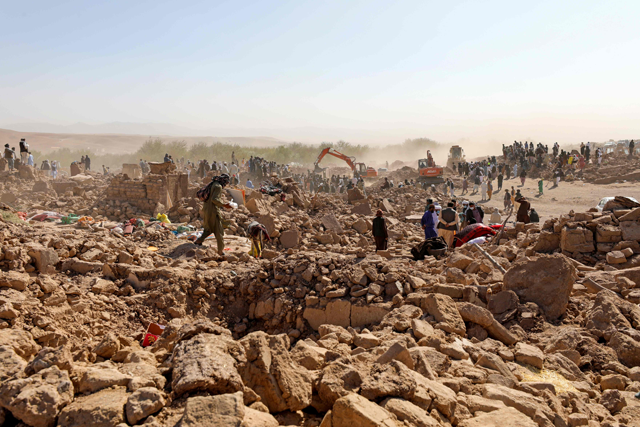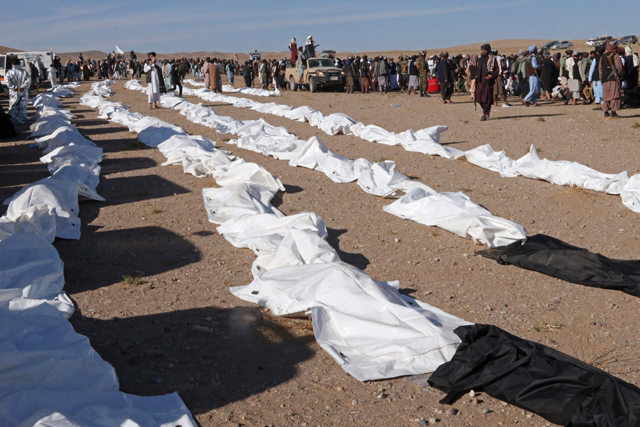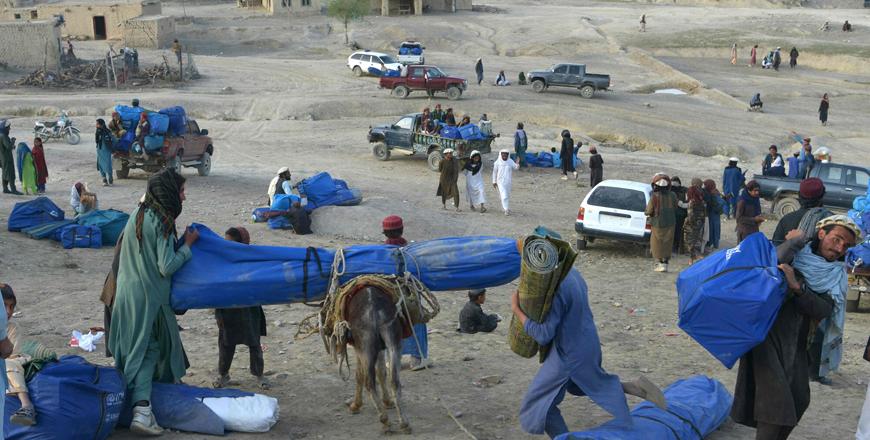You are here
Death toll from 'unprecedented' Afghan quakes doubles to 2,000
By AFP - Oct 09,2023 - Last updated at Oct 09,2023

Afghan residents clear debris as they look for victims' bodies in the rubble of damaged houses after the earthquakes in Siah Ab village, Zendeh Jan district of Herat province on Sunday (AFP photo)
Herat, Afghanistan — The death toll from a series of earthquakes in western Afghanistan rose sharply on Sunday to more than 2,000, the Taliban government said, as bodies continued to be pulled from demolished villages and buried in mass graves.
More than 1,300 homes were toppled when Saturday's magnitude 6.3 quake, followed by eight strong aftershocks, jolted hard-to-reach areas 30 kilometres northwest of the provincial capital of Herat, according to officials.
In the rural Zinda Jan district, village households were reduced to jumbles of broken masonry, where makeshift rescue teams continued to dig frantic trenches on Sunday.
Aid gradually trickled into the disaster zone including food, water, tents and coffins for the dead who were pulled from the rubble by excavators and men with pickaxes and shovels.
Some of the bodies were shrouded in fleece blankets, as workers used those same tools to excavate their communal graves in the gravelly brown earth.
Disaster management ministry spokesman Mullah Janan Sayeq said the nation “witnessed an unprecedented earthquake”, putting the number of dead at 2,053 across 13 villages around midday Sunday.
“For the treatment of the victims of the incident we are doing our best,” he told reporters in Kabul. “On-site search operations in the affected area are ongoing.”
He also gave a figure of more than 9,000 injured but later retracted that, saying it referred to the number of residents in the affected area.
One further aftershock of magnitude 4.2 hit the same area around 7:00am (0230 GMT) on Sunday morning, according to the United States Geological Survey.
‘Everything
turned to sand’
In the Sarboland village of Zinda Jan district, an AFP reporter saw homes ruined near the epicentre of the quakes, which shook the area for more than five hours.
Gutted homes showed personal belongings flapping in the harsh wind, as women and children lingered out in the open.
“In the very first shake all the houses collapsed,” said 42-year-old Bashir Ahmad.
“Those who were inside the houses were buried,” he said. “There are families we have heard no news from.”
Nek Mohammad told AFP he was at work when the first quake struck at around 11:00am (0630 GMT).
“We came home and saw that actually there was nothing left. Everything had turned to sand,” said the 32-year-old, adding that around 30 bodies had been recovered.
“So far, we have nothing. No blankets or anything else. We are here left out at night with our martyrs,” he said.
Casualties set to rise
Most rural homes in Afghanistan are made of sun-fired mud bricks built around wooden support poles, with little in the way of modern steel reinforcement.
Multigenerational extended families generally live under the same roof, meaning disasters like Saturday’s quake can devastate local communities.
In Herat city, residents fled their homes and schools, while hospitals and offices evacuated when the first quake was felt. There were few reports of casualties in the metropolitan area.
Afghanistan is already suffering a dire humanitarian crisis, with the widespread withdrawal of foreign aid following the Taliban’s return to power in 2021.
Save the Children called the quake “a crisis on top of a crisis”.
“The scale of the damage is horrific. The numbers affected by this tragedy are truly disturbing,” said country director Arshad Malik.
Herat province, home to around 1.9 million people on the border with Iran, has also been hit by a years-long drought that has crippled many hardscrabble agricultural communities.
Afghanistan is frequently hit by earthquakes, especially in the Hindu Kush mountain range, which lies near the junction of the Eurasian and Indian tectonic plates.
More than 1,000 people were killed and tens of thousands left homeless in June last year after a 5.9-magnitude quake struck the impoverished province of Paktika.
“The Herat earthquake is worse than the eastern earthquake that happened last year,” said disaster agency spokesman Janan.
“Not only by the magnitude and depth, but also more areas are affected and destroyed.”
Related Articles
NAYEB RAFI, Afghanistan — Thousands of Afghans who survived a powerful earthquake that killed more than 2,000 people were bracing for a wint
ZINDAH JAN, Afghanistan — Children sit shoulder to shoulder crammed in rows on the floor of a shipping container with lesson books in their
SPERA DISTRICT, Afghanistan — When Gul Nayeb Khan tried to claim a parcel of aid for earthquake victims being handed out in eastern Afghanis













